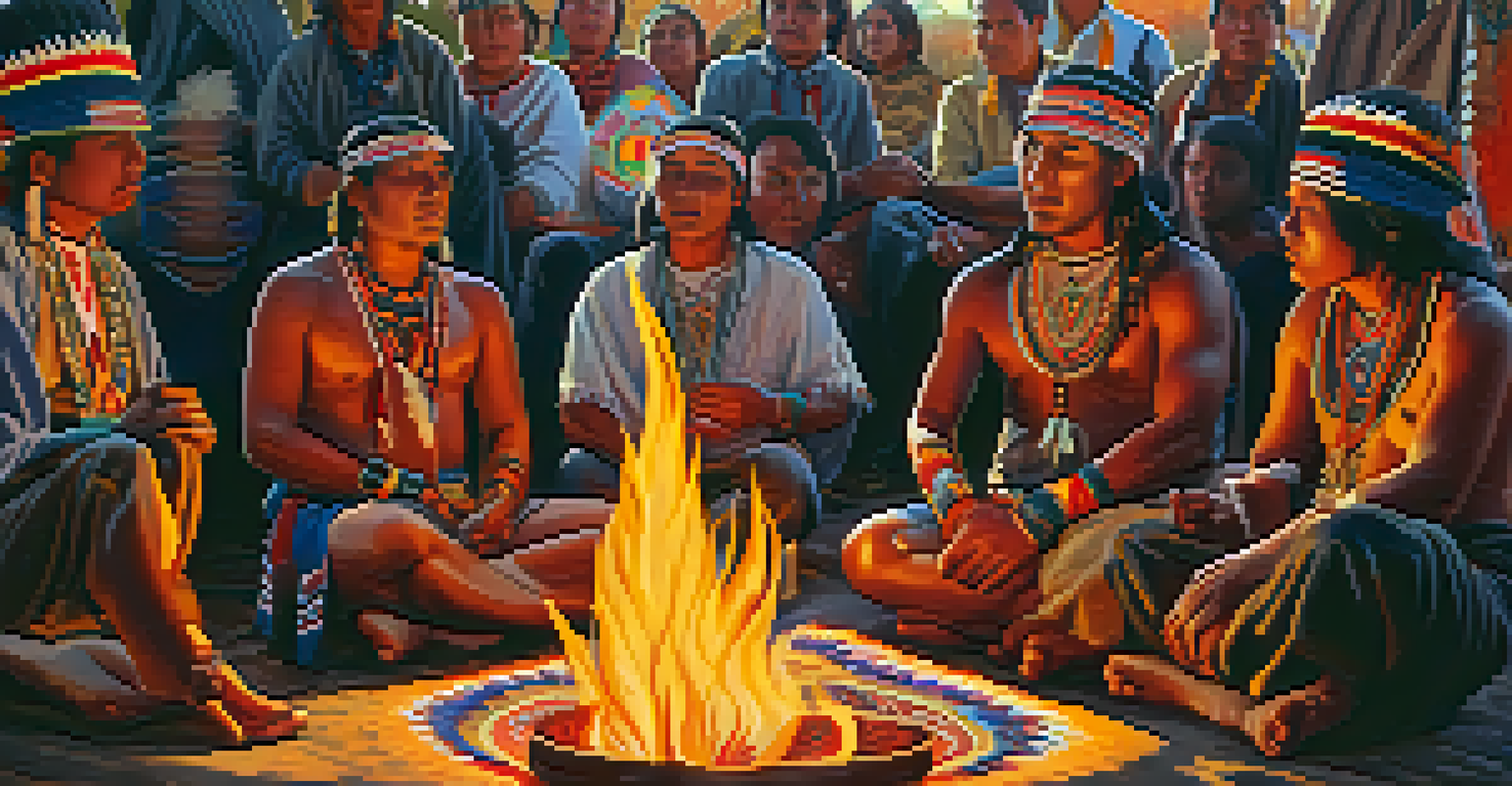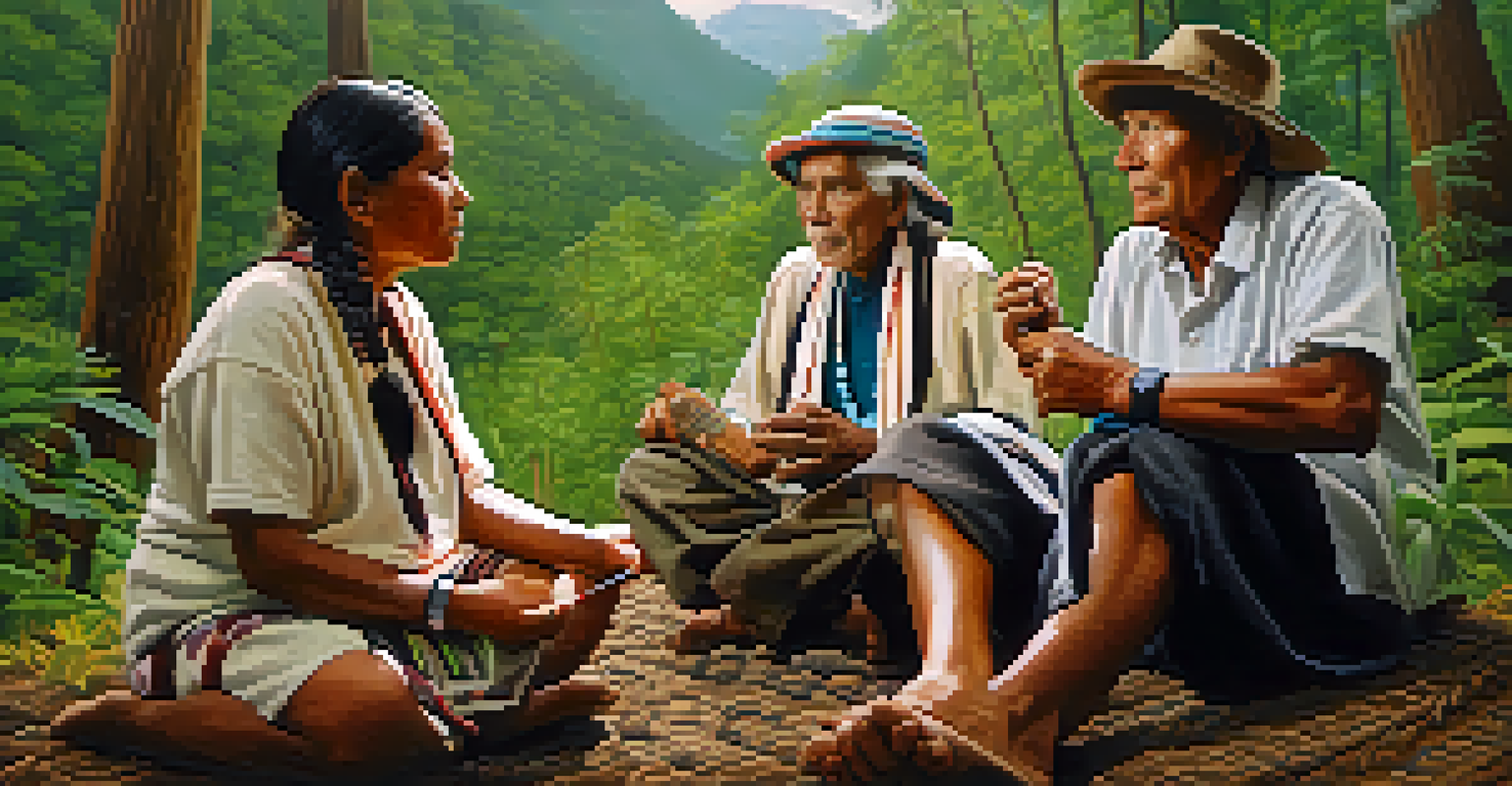Modern Indigenous Movements and the Use of Peyote

Understanding Indigenous Movements in the Modern Era
Indigenous movements have gained momentum in recent decades, advocating for rights, recognition, and cultural preservation. These movements are often rooted in a rich history of resilience and struggle against colonialism. From land rights to environmental justice, Indigenous communities are uniting to reclaim their voice and autonomy.
The land is sacred. It is not ours. It is a gift from our ancestors, and we hand it to our descendants.
The modern era has seen a resurgence of traditional practices and beliefs, as Indigenous peoples strive to assert their identity in a rapidly changing world. This resurgence is not just about reclaiming past traditions; it’s about adapting to contemporary challenges while honoring cultural heritage. For many, these movements offer a sense of belonging and community.
Moreover, Indigenous movements are increasingly intersecting with global issues, such as climate change and social justice. As they advocate for their rights, they also contribute to broader conversations about sustainability and equity. In this context, the use of traditional substances like peyote becomes a vital aspect of cultural expression and activism.
The Cultural Significance of Peyote
Peyote, a small cactus native to North America, has been used for centuries by Indigenous peoples for spiritual and medicinal purposes. Its psychoactive properties are often employed in ceremonial contexts, allowing participants to connect with their ancestors and the natural world. For many tribes, peyote is more than just a plant; it embodies a sacred relationship with nature and spirituality.

The use of peyote is deeply intertwined with rituals and community gatherings, fostering a sense of unity and collective healing. During ceremonies, participants often report transformative experiences that promote personal and communal well-being. This highlights the importance of peyote as a tool for not just individual enlightenment but also social cohesion.
Indigenous Rights and Cultural Identity
Indigenous movements advocate for the recognition of their rights and the preservation of their cultural identity in a modern context.
However, the cultural significance of peyote is often misunderstood or overlooked by outsiders. It's essential to recognize that its use is embedded in a larger framework of Indigenous spirituality and identity. As such, respecting the traditions surrounding peyote is crucial for fostering understanding and support for Indigenous rights.
Legal Challenges Facing Peyote Use
Despite its importance, the use of peyote faces significant legal hurdles in many regions. In the United States, for instance, peyote is classified as a Schedule I controlled substance, which complicates its use in religious ceremonies. This creates tension between the rights of Indigenous peoples to practice their traditions and the legal framework governing drug use.
Indigenous peoples have an inherent right to self-determination and to follow their own cultural and spiritual practices.
Some legal protections exist, such as the American Indian Religious Freedom Act, which acknowledges the right of Indigenous people to use peyote in religious ceremonies. However, these protections are often limited and can vary by state, leading to ongoing legal battles. This inconsistency can create uncertainty for communities that rely on peyote for spiritual practices.
Furthermore, the criminalization of peyote use often intersects with broader issues of systemic racism and oppression faced by Indigenous peoples. Advocates argue that recognizing the rights of Indigenous communities to use peyote is a necessary step toward justice and reconciliation. The struggle for legal recognition is thus an integral part of the larger Indigenous rights movement.
Peyote and Contemporary Spiritual Practices
Many Indigenous communities continue to incorporate peyote into their spiritual practices, adapting rituals to fit contemporary contexts. These adaptations may include combining traditional ceremonies with modern elements, creating a dynamic spiritual practice that resonates with younger generations. This evolution is crucial for keeping cultural traditions alive and relevant.
The use of peyote in spiritual practices also serves as a form of resistance against cultural assimilation. By maintaining these traditions, Indigenous peoples assert their identity and challenge dominant narratives that seek to erase their heritage. This act of reclaiming spirituality is not just about the substance; it's about reaffirming cultural identity and community bonds.
Peyote's Role in Healing Practices
Peyote serves as a significant tool for spiritual and physical healing within Indigenous communities, linking traditional practices with contemporary therapeutic approaches.
Moreover, the rise of interest in psychedelics among non-Indigenous populations has sparked discussions about the ethical implications of peyote use. Non-Indigenous individuals seeking spiritual experiences must navigate the complexities of cultural appropriation and respect for Indigenous traditions. This highlights the need for dialogue and education regarding the sacred nature of peyote.
The Role of Peyote in Healing and Wellness
Peyote is often viewed as a powerful tool for healing, both physically and spiritually. Many Indigenous peoples use it in ceremonies aimed at addressing personal and communal traumas, promoting mental health and well-being. The experiences facilitated by peyote can lead to profound insights and emotional release, contributing to holistic healing practices.
In recent years, there has been a growing interest in the therapeutic potential of psychedelics, including peyote, in mainstream medicine. This has led to increased research into how such substances can support mental health treatment, particularly for conditions like PTSD, depression, and anxiety. The intersection of traditional Indigenous practices and modern therapeutic approaches offers exciting possibilities for healing.
However, it is essential to approach this intersection with caution and respect. Indigenous communities must retain agency over their traditions, ensuring that the use of peyote for therapeutic purposes does not exploit their cultural practices. The dialogue around peyote and wellness should prioritize Indigenous voices and perspectives to ensure ethical engagement.
Community Advocacy and Education about Peyote
Education is crucial in advocating for the rights of Indigenous peoples to use peyote. Many organizations are working to raise awareness about the cultural significance of peyote and the challenges faced by Indigenous communities in its use. By fostering understanding among the broader public, these efforts aim to build support for Indigenous rights and practices.
Community-led initiatives often focus on sharing knowledge about the historical and spiritual importance of peyote. Workshops, seminars, and cultural exchanges provide opportunities for non-Indigenous individuals to learn directly from Indigenous peoples. Such initiatives not only educate but also create spaces for dialogue and collaboration.
Legal Challenges for Peyote Use
Despite its cultural importance, peyote use faces legal obstacles that hinder Indigenous peoples' rights to practice their traditions freely.
Furthermore, advocacy efforts are essential in promoting legal reforms that protect the rights of Indigenous peoples to use peyote. By mobilizing support and engaging with policymakers, advocates can work towards ensuring that Indigenous spiritual practices are respected and protected within the legal framework. This collaborative approach is vital for fostering a more inclusive society.
Future Perspectives on Peyote and Indigenous Rights
Looking ahead, the future of peyote use within Indigenous movements will likely continue to evolve. As more people become aware of the cultural significance of peyote, it may lead to increased advocacy for legal protections and recognition. This growing awareness could also help combat stereotypes and misconceptions surrounding Indigenous practices.
Additionally, the ongoing dialogue about psychedelics in mainstream culture may open up new avenues for collaboration between Indigenous and non-Indigenous communities. By working together, there is potential to create respectful frameworks that honor Indigenous traditions while exploring the therapeutic benefits of peyote. This could lead to a more nuanced understanding of its role in healing.

Ultimately, the future of peyote and Indigenous rights will depend on the commitment of both Indigenous communities and allies to advocate for justice and respect. By prioritizing Indigenous voices and perspectives, we can work towards a future where the spiritual and cultural significance of peyote is recognized and celebrated.